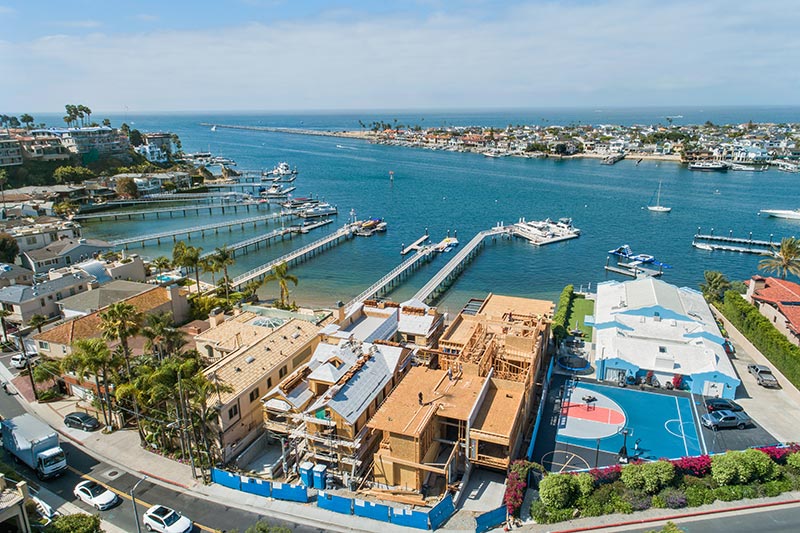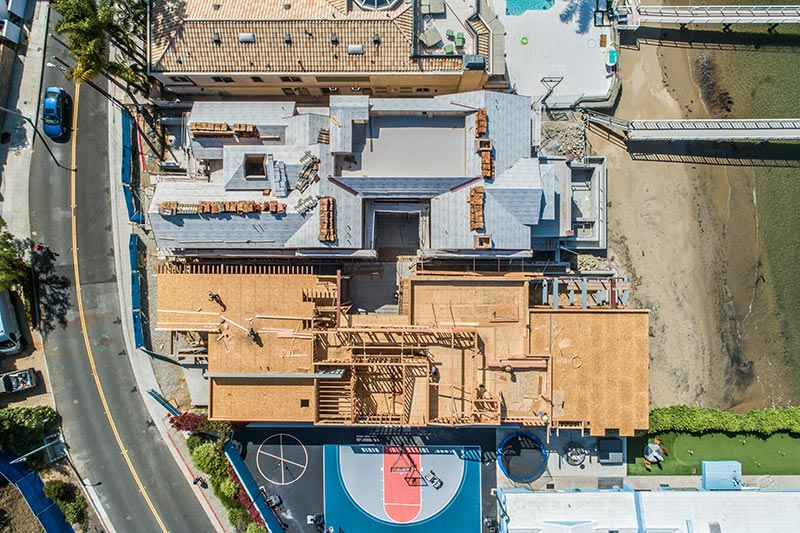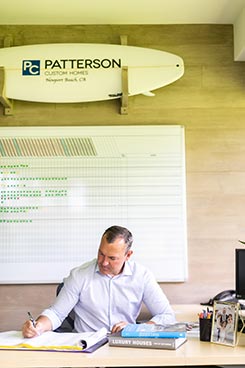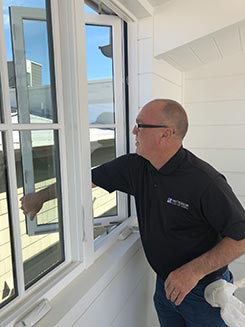Do you want to build your dream home, but aren’t sure where to start?
If this is your first time building a new home you might be wondering about the process, and find yourself asking questions such as how will I know how much things will cost? or, how can I be sure the budget won’t have doubled by the time the project is finished?
These are important things to be thinking about, and since the cost of construction will vary based on the builder you talk to, we are sharing a few tips to help you get started.

Our neighboring Bayside Drive projects under construction, captured by Stone Harbor Media Group with architecture by Brandon Architects.
Materials & Scope
To begin, the price per square foot that you are quoted will be relative to what each general contractor includes in terms of materials and scope. It is important to ask your general contractor about materials and techniques so you know what you can expect in return for your investment. Most builders’ quotes are based on the materials that are required by code, but a smaller number of builders like ourselves use only the highest quality materials that far exceed what is required by code so that the home will last.
The difference in the quality of the materials used in home building matters, especially when it comes to the home’s location and the elements it will be exposed to. If you are planning to build in a coastal climate for example, your home will inevitably be in contact with the salty sea air – and as we all remember from science class, the combination of moisture, oxygen, and salt makes for one corrosive cocktail. Even though copper flashing is a more expensive material that exceeds what is required by code, we proactively choose to use it in our homes because it will not deteriorate in the salty air and will not need to be replaced over time. Copper can last for nearly 100 years, while galvanized steel – the flashing material that meets the requirements for building code – will usually only last for 15 years. In addition to copper flashing we also recommend the use of other higher quality building materials such as cast iron waste lines, 5/8” thick drywall, and 2’x6’ framing studs. The initial price per square foot for a home that comes with these upgraded materials will be higher, but the use of these stronger materials will prevent costly material replacements and repairs later and will help to increase the home’s future resale price.
Budget Accuracy & Fees
Once you’ve met with a builder, have been given a quote, and understand the scope and materials included in that quote, the next thing to think through is how accurate that proposed quote may or may not be. As an open book contractor, we create our budgets based on data. Using the real costs from previous and current projects, we create a preliminary cost estimate for our clients which includes not only the true cost of materials and labor but also realistic allowances for design materials and finishes such as tile and stone, lighting, and appliances. Once the preliminary cost estimate has been reviewed and approved by the client, we send the project details to our subcontractors and vendors for bids. We then use the real costs we receive back from them to finalize the budget. All of this happens before construction even begins so the client knows the total cost before we start. However, this is not a standard practice across the industry.
 Along those same lines, it is also important to consider the general contractor’s fee structure. The general contractor must factor in how he or she will make a profit. Some choose to charge a very minimal percentage of the total construction cost along with a monthly site supervision fee, whereas other builders like ourselves opt to charge a slightly higher percentage of the total construction cost but eliminate the monthly fee. When comparing quotes, the first model may sound better initially with a lower percentage fee, but the problem with this model is that the builder is motivated to keep the project under construction for as long as possible in order to make up those percentage points via the monthly site supervision fee. This will impact your budget in two ways: first, you will not have a maximum cap on the budget, so if the general contractor cannot stick to the timeline he or she quoted, you will continue to pay this fee for every additional month that goes by; and second, a project that is set up to stay under construction for as long as possible will result in you paying additional monthly mortgage or rent payments for the home you are living in while you wait for move-in day (not to mention the non-monetary expense of the added stress!).
Along those same lines, it is also important to consider the general contractor’s fee structure. The general contractor must factor in how he or she will make a profit. Some choose to charge a very minimal percentage of the total construction cost along with a monthly site supervision fee, whereas other builders like ourselves opt to charge a slightly higher percentage of the total construction cost but eliminate the monthly fee. When comparing quotes, the first model may sound better initially with a lower percentage fee, but the problem with this model is that the builder is motivated to keep the project under construction for as long as possible in order to make up those percentage points via the monthly site supervision fee. This will impact your budget in two ways: first, you will not have a maximum cap on the budget, so if the general contractor cannot stick to the timeline he or she quoted, you will continue to pay this fee for every additional month that goes by; and second, a project that is set up to stay under construction for as long as possible will result in you paying additional monthly mortgage or rent payments for the home you are living in while you wait for move-in day (not to mention the non-monetary expense of the added stress!).
In comparison, a client who chooses to hire a builder who does not charge an additional monthly fee knows the total price of their contract up front. Because there is no monthly fee, the builder is incentivized to adhere to the schedule for the client and will work proactively to avoid delays.
 Timeline
Timeline
This brings us to the next point – the timeline. How can you be sure the builder’s projected schedule is accurate, even if there isn’t a monthly fee involved? An important question to ask is whether he or she is using real data to create this schedule. Just like we track costs from previous projects, we also track how long each phase of the build has taken on every project we have built to date, and we use that data to forecast future project timelines and know when different subcontractors will be needed. This data also informs the decision deadline schedules that we give to our clients to help keep the project on track. When it comes to the timeline it is important to ask the builder how they arrived at their projected schedule so you can determine if it is realistic, and to emphasize the above point, what their fee structure is so you can see if they will be incentivized to meet their target completion date.
Project Team
In addition to the general contractor, it is important to think about the other project team members involved. The architect, interior designer, and structural engineers will have their own fees in addition to the general contractor’s fee. Having cohesion among independent teams that work together is paramount for the project’s success. It is important to be selective with your other project team members so that all parties involved are organized, professional, and can work within your budget. At Patterson we like to get involved with our clients early on so that we can make introductions to the area’s leading architects and interior designers who have strong processes in place. As we rely on these teams for the details that we execute, the selection of a strong project team on the front end helps to minimize the number of costly mistakes and change orders that can otherwise occur when independent teams are not in alignment.

Our Custom Care Manager inspecting the weather stripping for one of our clients enrolled in our Custom Care Program.
On-Going Maintenance
The final thing to think about regarding the cost of building a home is the cost of on-going maintenance after you move in. As we mentioned previously, if the home is built with superior materials there will be fewer replacement and repair costs needed in the future, but if you are interested in protecting your largest asset it will need to be maintained over time (just like your car needs a routine oil change, your home needs to be regularly serviced too). At Patterson, we created our own preventative home maintenance program – the Patterson Custom Care Program – to help our clients once they move in. From replacing the home’s air filters to servicing the HVAC units and adjusting the garage doors, we help our clients keep up with the routine maintenance needs of their home so that it will last for generations to come. If your builder does not offer an aftercare service, we strongly recommend hiring independent service providers to assist you in the process.
Ready to Get Started?
With so many factors that can affect the cost of construction it’s important to choose a builder who has a strong process in place so you can be confident your project will stay within budget and meet your expectations. At Patterson we’re proud to offer a white-glove approach to custom home building – from our use of building materials and techniques that go beyond what is required by code, to our data-driven budgets and timelines, and by offering a one-of-a-kind preventative home maintenance service to help our clients care for their homes post-completion.
If you’re looking to build in coastal Orange County it would be our pleasure to help you bring your dream home to life. We’re ready to get started on your project – are you?
Andrew Discusses the Business on the HIPERleadship Podcast
In this episode of the HIPERleadership podcast, Andrew joins David Morris for a conversation about extraordinary leadership and what The New Standard in custom homebuilding means. The two discuss why using data to inform your decision-making is paramount for your success, and how being proactive in keeping all stakeholders aligned before, during, and after construction can lead to better outcomes.


